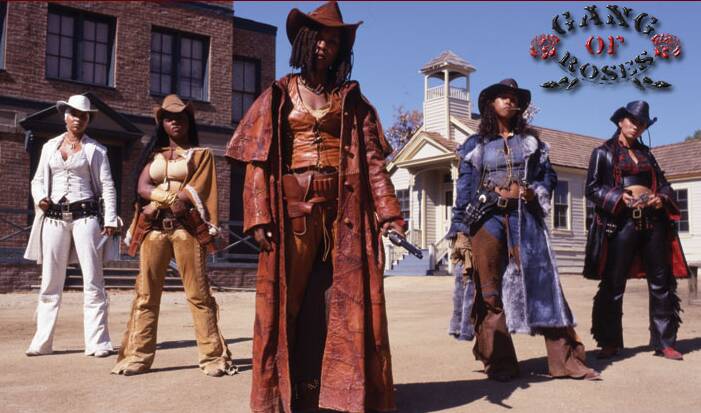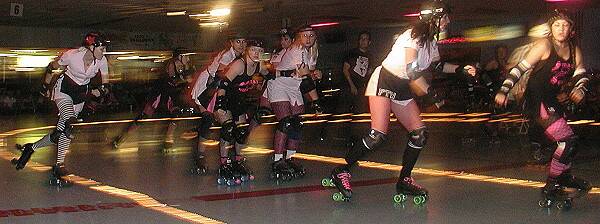 Roller Derby is quintessentially American; like the drive-in, it’s rarely seen outside the US. And also like the drive-in, it began in the 1930’s, when Chicago’s Leo Seltzer combined two crazes: roller-skating and the dance marathon. His contest for couples, over 57,000 laps (the distance between Los Angeles and New York). drew 20,000 spectators in its opening week. The power of the concept was proven, but it took a few years for it to evolve into a contact sport – Damon Runyon, author of Guys and Dolls, helped Seltzer incorporate these elements, and also the change in aim from distance to the scoring of points.
Roller Derby is quintessentially American; like the drive-in, it’s rarely seen outside the US. And also like the drive-in, it began in the 1930’s, when Chicago’s Leo Seltzer combined two crazes: roller-skating and the dance marathon. His contest for couples, over 57,000 laps (the distance between Los Angeles and New York). drew 20,000 spectators in its opening week. The power of the concept was proven, but it took a few years for it to evolve into a contact sport – Damon Runyon, author of Guys and Dolls, helped Seltzer incorporate these elements, and also the change in aim from distance to the scoring of points.
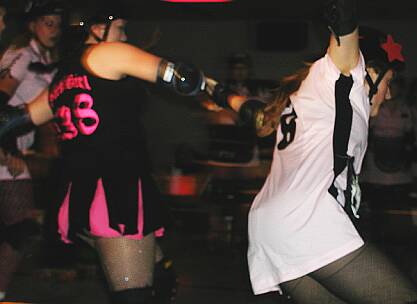 The golden era of the sport began in the 1950’s, when television helped roller derby become popular in almost every state. However, the 1970’s saw it go into decline, and it has never recovered, despite attempts to revive it. Most recently, there was RollerJam, an exercise closer to professional wrestling and co-funded by TNN, that stumbled along despite the assistance of Leo Seltzer’s son, Jerry, and finally went under in June 2000.
The golden era of the sport began in the 1950’s, when television helped roller derby become popular in almost every state. However, the 1970’s saw it go into decline, and it has never recovered, despite attempts to revive it. Most recently, there was RollerJam, an exercise closer to professional wrestling and co-funded by TNN, that stumbled along despite the assistance of Leo Seltzer’s son, Jerry, and finally went under in June 2000.
A minor footnote in American pop culture? Perhaps. Yet it survives, with federations in Texas, California and even the Cayman Islands, not to mention here in Arizona. An impressive crowd, several hundred strong, turned up on a Saturday night and paid $10 to attend a double-header of roller derby, at Surfside Skateland in Phoenix. The Furious Truckstop Waitresses came up from Tucson to challenge the hometown Smashers, while the French Kiss Army took on the Bruisers. Women? Action? Violence? Naturally, we here at gwg.org wouldn’t miss that, and the chance to see what is perhaps the only contact sport played mostly by women.
A quick explanation of the basic rules, as played in AZ Roller Derby – they’re little changed from the ones created by Seltzer and Runyon back in the early days. There are two teams of five players. One from each side is designated the jammer, and these two start off a little way behind the other players. Their initial task is to make their way through the pack – the first to do so is the “lead jammer” and can end the bout at any point she deems tactically prudent (if she doesn’t, they last a maximum of two minutes).
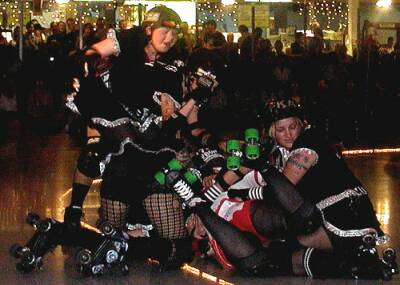 After getting through, the jammers then lap the pack, and again approach it from behind. Only this time, they score one point for every opponent they pass. Which is where the fun starts, since the opposition is trying to block them, and their team-mates are trying to block the blockers, while also stopping the opposition’s jammer from passing them and scoring. A match consists of two periods, each lasting twenty minutes; most points wins.
After getting through, the jammers then lap the pack, and again approach it from behind. Only this time, they score one point for every opponent they pass. Which is where the fun starts, since the opposition is trying to block them, and their team-mates are trying to block the blockers, while also stopping the opposition’s jammer from passing them and scoring. A match consists of two periods, each lasting twenty minutes; most points wins.
The opportunities for violence are obvious, and are reflected in players who adopt nommes des guerre such as Mayhemily, Joan Threat [along with her cute-as-a-button little daughter, Kitty Ka-Boom, who had her own uniform], Kim Sin and Ann Ihilate. The creative imagination extends further: the Bruisers’ uniforms were patterned after nurses (down to the little white peak and red cross on their helmets), while the Furious Truckstop Waitresses were…well, work it out yourselves.
There are rules which stipulate the types of blocking allowed, but despite the presence of multiple referees, penalties seemed to be rarely enforced. Even when the occasional fight broke out – usually after one player took exception to a block by another – the referees stood back for a bit before interfering, realising that, in truth, this was what the bulk of the audience wanted to see. With helmets compulsory, odds were against any significant injury, and while one suspected everyone involved heads down the bar and has a drink afterwards, this does not reduce the guilty pleasure involved in the spectacle.
 I was a little surprised to see a flat track, it was simply marked out on the surface of the rink with rope lights; the teams are working towards banking, and have weekly fundraisers at Ziggy’s in Tempe – including a spanking booth! For the moment, they make do and, regardless, the pace was fast and furious; while the skating ability on view was variable, these women are athletes, make no mistake about it. The best jammers, such as Sara Veza and Go Go Liz, slid through the pack like a knife through butter. Even rookies like ourselves could see the skill required, while perhaps not appreciating the subtle refinements of the sport. [Alright, “subtle” is stretching it. There’s a whole page on their website, with photos of the injuries players have received…]
I was a little surprised to see a flat track, it was simply marked out on the surface of the rink with rope lights; the teams are working towards banking, and have weekly fundraisers at Ziggy’s in Tempe – including a spanking booth! For the moment, they make do and, regardless, the pace was fast and furious; while the skating ability on view was variable, these women are athletes, make no mistake about it. The best jammers, such as Sara Veza and Go Go Liz, slid through the pack like a knife through butter. Even rookies like ourselves could see the skill required, while perhaps not appreciating the subtle refinements of the sport. [Alright, “subtle” is stretching it. There’s a whole page on their website, with photos of the injuries players have received…]
Did find it hard to keep track of the jammers; they have a star on their helmet but, especially on the far side of the track, it’s hard to see. Maybe some kind of yellow/orange bib would work better? The scoreboard was often some way behind the action, though since the scorekeeper was hobbling around on a broken ankle, it’s hard to be too critical. And while the action was fast and furious when it happened, four 20-minute periods took 3 1/2 hours to complete, thanks to the lengthy intermissions. Entertainment therein was provided by a couple of bands, but given an audience reaction that could be described as ‘indifferent’ (and that’s being kind), they might be better off scrapping that, and getting everything done in two hours. Perhaps it’s just me – in Britain, a ninety-minute football game takes an hour forty-five, tops – but we were there for roller derby, and everything else was, inevitably, filed under ‘pointless distraction’.
However, we remained enormously impressed: as a mix of sport, entertainment and spectacle, it was a damn fine evening, and the effort the participants put in was clear to all. Oh, and for the record, the Smashers beat the Furious Truckstop Waitresses, in a contest that went right down to the wire, while the French Kiss Army staged a come-from-behind victory to defeat the Bruisers. We’re certainly up for the rematch next month!
[Postscript. Kim Sin, of the Furious Truckstop Waitresses, wrote in to say, “Cool story, but you failed to mention FTW is not part of AZRD; we are our own league of two teams in Tucson, Tucson Roller Derby, a non-profit organization. We work with AZRD, but are a totally separate entity.” And their website is at http://www.tucsonrollerderby.com]

 Four unlikely women team up, for their own but unselfish reasons, in order to rob the bank where one (Ozores) works as a cleaning lady. There’s also a rich bankrupt, out to fund her daughter’s wedding; a slutty hairdresser who’s just found out she’s pregnant; and an antisocial punk orphan, who wants to be reunited with her father in Argentina. What makes this Spanish film work, is less the action, and more the characters – or at least, the women, since the men never become more than two-dimensional. The script is brisk and efficient, moving things along with swift abandon, and sucks the viewer in to a connection with the ladies, their problems, and the solution.
Four unlikely women team up, for their own but unselfish reasons, in order to rob the bank where one (Ozores) works as a cleaning lady. There’s also a rich bankrupt, out to fund her daughter’s wedding; a slutty hairdresser who’s just found out she’s pregnant; and an antisocial punk orphan, who wants to be reunited with her father in Argentina. What makes this Spanish film work, is less the action, and more the characters – or at least, the women, since the men never become more than two-dimensional. The script is brisk and efficient, moving things along with swift abandon, and sucks the viewer in to a connection with the ladies, their problems, and the solution.




 Roller Derby is quintessentially American; like the drive-in, it’s rarely seen outside the US. And also like the drive-in, it began in the 1930’s, when Chicago’s Leo Seltzer combined two crazes: roller-skating and the dance marathon. His contest for couples, over 57,000 laps (the distance between Los Angeles and New York). drew 20,000 spectators in its opening week. The power of the concept was proven, but it took a few years for it to evolve into a contact sport – Damon Runyon, author of Guys and Dolls, helped Seltzer incorporate these elements, and also the change in aim from distance to the scoring of points.
Roller Derby is quintessentially American; like the drive-in, it’s rarely seen outside the US. And also like the drive-in, it began in the 1930’s, when Chicago’s Leo Seltzer combined two crazes: roller-skating and the dance marathon. His contest for couples, over 57,000 laps (the distance between Los Angeles and New York). drew 20,000 spectators in its opening week. The power of the concept was proven, but it took a few years for it to evolve into a contact sport – Damon Runyon, author of Guys and Dolls, helped Seltzer incorporate these elements, and also the change in aim from distance to the scoring of points. The golden era of the sport began in the 1950’s, when television helped roller derby become popular in almost every state. However, the 1970’s saw it go into decline, and it has never recovered, despite attempts to revive it. Most recently, there was RollerJam, an exercise closer to professional wrestling and co-funded by TNN, that stumbled along despite the assistance of Leo Seltzer’s son, Jerry, and finally went under in June 2000.
The golden era of the sport began in the 1950’s, when television helped roller derby become popular in almost every state. However, the 1970’s saw it go into decline, and it has never recovered, despite attempts to revive it. Most recently, there was RollerJam, an exercise closer to professional wrestling and co-funded by TNN, that stumbled along despite the assistance of Leo Seltzer’s son, Jerry, and finally went under in June 2000. After getting through, the jammers then lap the pack, and again approach it from behind. Only this time, they score one point for every opponent they pass. Which is where the fun starts, since the opposition is trying to block them, and their team-mates are trying to block the blockers, while also stopping the opposition’s jammer from passing them and scoring. A match consists of two periods, each lasting twenty minutes; most points wins.
After getting through, the jammers then lap the pack, and again approach it from behind. Only this time, they score one point for every opponent they pass. Which is where the fun starts, since the opposition is trying to block them, and their team-mates are trying to block the blockers, while also stopping the opposition’s jammer from passing them and scoring. A match consists of two periods, each lasting twenty minutes; most points wins. I was a little surprised to see a flat track, it was simply marked out on the surface of the rink with rope lights; the teams are working towards banking, and have weekly fundraisers at Ziggy’s in Tempe – including a spanking booth! For the moment, they make do and, regardless, the pace was fast and furious; while the skating ability on view was variable, these women are athletes, make no mistake about it. The best jammers, such as Sara Veza and Go Go Liz, slid through the pack like a knife through butter. Even rookies like ourselves could see the skill required, while perhaps not appreciating the subtle refinements of the sport. [Alright, “subtle” is stretching it. There’s a whole page on their website, with photos of the injuries players have received…]
I was a little surprised to see a flat track, it was simply marked out on the surface of the rink with rope lights; the teams are working towards banking, and have weekly fundraisers at Ziggy’s in Tempe – including a spanking booth! For the moment, they make do and, regardless, the pace was fast and furious; while the skating ability on view was variable, these women are athletes, make no mistake about it. The best jammers, such as Sara Veza and Go Go Liz, slid through the pack like a knife through butter. Even rookies like ourselves could see the skill required, while perhaps not appreciating the subtle refinements of the sport. [Alright, “subtle” is stretching it. There’s a whole page on their website, with photos of the injuries players have received…]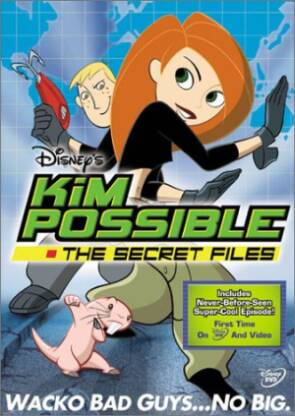 This compilation puts together four episodes – three from the first season, plus another at the time exclusive to the DVD. It’s hard to see who this is aimed at: if you’ve not seen the series, novices may find elements, such as Ron’s naked mole rat, kinda bizarre (trivia note: the rat’s squeaks are by Nancy Cartwright, who also does some loser called Bart Simpson). On the other hand, fans will have seen almost all the material, and would likely far rather have seen a complete Box Set rather than semi-random episodes. They’re not even particularly highly-regarded ones: the
This compilation puts together four episodes – three from the first season, plus another at the time exclusive to the DVD. It’s hard to see who this is aimed at: if you’ve not seen the series, novices may find elements, such as Ron’s naked mole rat, kinda bizarre (trivia note: the rat’s squeaks are by Nancy Cartwright, who also does some loser called Bart Simpson). On the other hand, fans will have seen almost all the material, and would likely far rather have seen a complete Box Set rather than semi-random episodes. They’re not even particularly highly-regarded ones: the 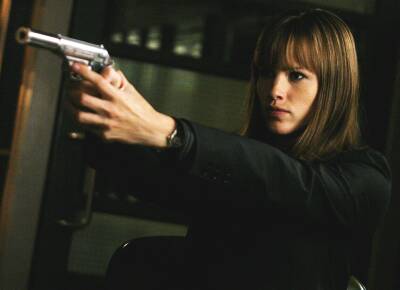 Where is Sydney, and what have you done with her? We might have been forgiven for uttering this cry at the end of season three, which exited not with a bang, but a whimper. “We need to talk.” That’s pretty much what Jack said to Sydney after she discovered, apparently, that her entire life had been a CIA operation. This was hardly a surprise, if you remembered Project Christmas from earlier on, Jack’s plan which tested first-graders – including his own daughter – for spyworthy attributes. The news that the show wouldn’t restart until January 2005 thus provoked little more than mild disappointment.
Where is Sydney, and what have you done with her? We might have been forgiven for uttering this cry at the end of season three, which exited not with a bang, but a whimper. “We need to talk.” That’s pretty much what Jack said to Sydney after she discovered, apparently, that her entire life had been a CIA operation. This was hardly a surprise, if you remembered Project Christmas from earlier on, Jack’s plan which tested first-graders – including his own daughter – for spyworthy attributes. The news that the show wouldn’t restart until January 2005 thus provoked little more than mild disappointment.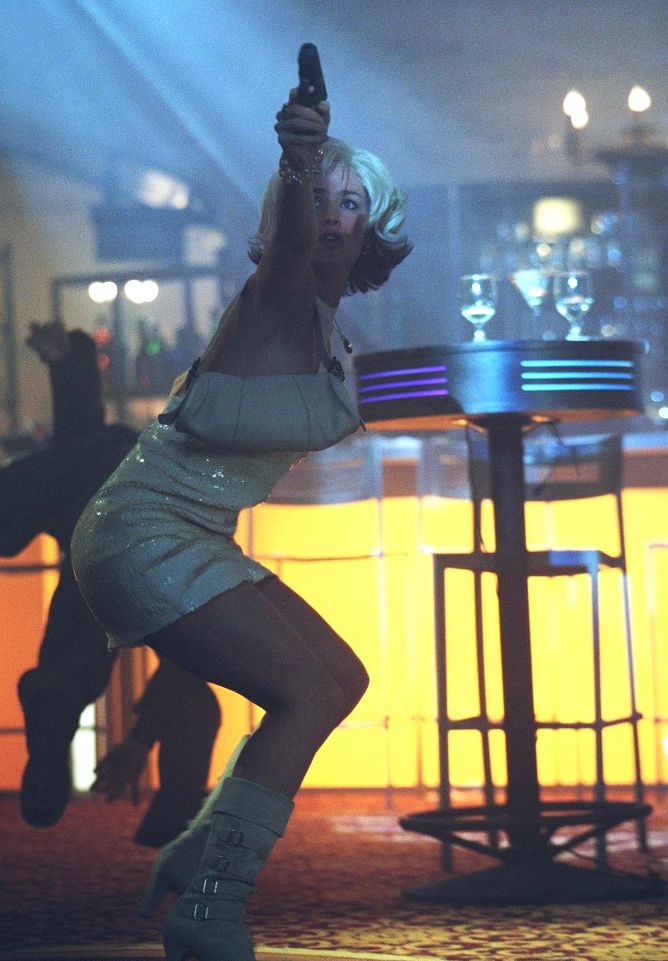
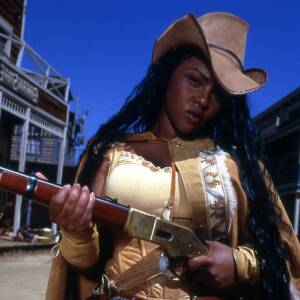 This comes across less like a Western, more like a feature-length rap promo – with every bit as much emotional depth or historical accuracy. The idea that a gang of ethnic gun-toting women could ever ride into town at the turn of the century, and get served at the local saloon with little problem stretches credulity to near-breaking. It then snaps entirely when faced with their always-immaculate clothes and hair, even as the ladies sleep rough. The group of former bank-robbers return to the fray after the sister of one is killed by outlaws, under the control of the one-eyed Bobby Brown. Insert Whitney Houston joke here. He and his gang have taken control of a town, from a sheriff with a startlingly Australian accent, as part of their search for treasure supposedly buried locally.
This comes across less like a Western, more like a feature-length rap promo – with every bit as much emotional depth or historical accuracy. The idea that a gang of ethnic gun-toting women could ever ride into town at the turn of the century, and get served at the local saloon with little problem stretches credulity to near-breaking. It then snaps entirely when faced with their always-immaculate clothes and hair, even as the ladies sleep rough. The group of former bank-robbers return to the fray after the sister of one is killed by outlaws, under the control of the one-eyed Bobby Brown. Insert Whitney Houston joke here. He and his gang have taken control of a town, from a sheriff with a startlingly Australian accent, as part of their search for treasure supposedly buried locally.